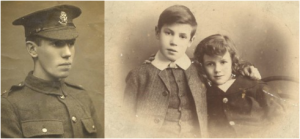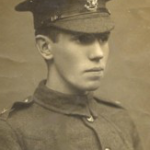
12th July 1917, aged 19. Born Hull.
Born Hull 25/05/1898. Son of Oswald Malcolm Ellis (1871-1940) and Edith Josephine Smith (1873-1935). Lived 27 Denzil Avenue, Southampton. Eldest of two sons.
GUY ELLIS was studying for his Intermediate Civil Service exam when, on 29th September 1915, he joined the London Regiment (Artists’ Rifles) at Dukes Road W.C. at the age of seventeen years 4 months. The medical showed that he was 5’ 7.5″ with a 37″ chest. His physical development was described as “fair”.
Appointed Lance Corporal on 22nd April 1916, Guy had been languishing at Hare Hall Camp in Romford, Essex. He decided to apply for admission to an officer cadet unit with a view to getting a temporary commission for the duration of the war.
Question 3. “State in order of preference which branch of the Service……” Guy wrote “Flying Corps” without hesitation.
His specific qualifications for the R.F.C. were considered by the selection board: “Rides a motorcycle (though not a horse); can sketch; slight knowledge of electricity; moderate knowledge of the internal combustion engine; knows the whole process of photography; had map reading course; maths 6 books of Euclid, Mechanics, Trigonometry, Algebra. Sports: first XI cricket and football at school; boxing; running (100 yds., ¼ mile, 220 yds., 120 yds., hurdles and high jump. Speaks French slightly”. Not perfect qualifications for a pilot perhaps, but knowledge of photography would be useful for an observer.
Guy was accepted at No.1 Officer Cadet Battalion at Denham in Bucks on 6th September 1916. From Denham, he was posted to Oxford reporting for duty there on 13th November. He received his commission on 27th January 1917. The fact was noted in the London Gazette on 3rd February.
Holding the rank of temporary 2nd Lieutenant, he was seconded to 57 squadron stationed near Ypres. Here Guy settled down to the harrowing life of a young flying officer on active service. For most it was a pitifully short life, relieved only by drinking and joking in the mess in between sorties.
In July 1917 a new offensive at Ypres was planned. The aim was twofold; to break through the German lines and reach their submarine bases in Belgium, and to relieve the Russian army in the east. The RFC was playing a significant role in the build up both in combat and in reconnaissance. On 11th July, some two weeks before the battle began, an allied air offensive involving 700 aircraft began. The following day, Thursday, one of these aircraft took off with Guy Ellis in the rear as observer. When he returned, he would have to think about settling his mess bill, now standing at £1-5-8. It is not known whether it was a fighter or ground fire that hit Guy’s plane, but as it plummeted towards earth, the one thing that might have saved him was a parachute. But it was not policy to give airmen parachutes, “…possession of a parachute might impair a pilot’s nerve when in difficulties so that he would make improper use of his parachute…”, was the official view. And so 19 year old Guy was dead. The odds were stacked against him anyway, for by now the life expectancy of a junior officer in a front line squadron was anything from eleven days to three weeks.
Guy found his final resting place at Vlamertinghe New Military Cemetery in Belgium, “a sturdy wooden cross” marking the spot.Â
